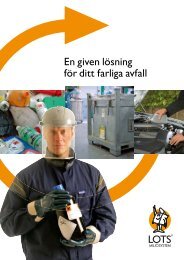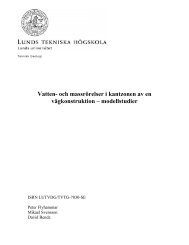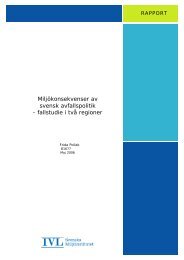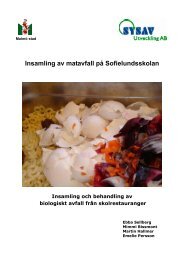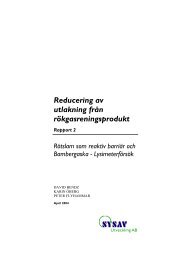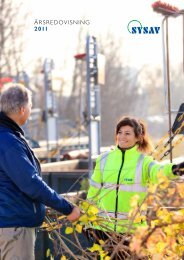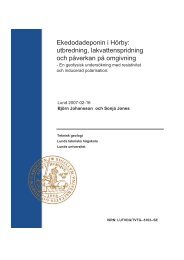Utvärdering av ett laktest för jordar kontaminerade med ... - Sysav
Utvärdering av ett laktest för jordar kontaminerade med ... - Sysav
Utvärdering av ett laktest för jordar kontaminerade med ... - Sysav
You also want an ePaper? Increase the reach of your titles
YUMPU automatically turns print PDFs into web optimized ePapers that Google loves.
Abstract<br />
In order to reach the Swedish environmental objective 'A Non-Toxic Environment' there is a<br />
need to make inventories of, and decontaminate, polluted sites. Approximately 80 000<br />
contaminated sites h<strong>av</strong>e been identified in Sweden and 16 500 of these are estimated to pose a<br />
large or very large risk to human health or to the environment. Decontamination of polluted<br />
sites is often accompanied by large costs. Therefore it is of great importance that priority is<br />
given to the right areas and that resources are used in an efficient way. Risk assessments of<br />
sites polluted with organic compounds are often based on estimations of the soil solute<br />
concentration from measured total contents of the contaminants in the area. However, this<br />
method has proven to be inadequate. There is therefore a need for reliable experimental<br />
methods describing the equilibrium distribution of organic contaminants between soil<br />
particles and solute in order to make more realistic estimates of the soil solute concentration,<br />
and thus the potential for transport and leaching, of the contaminants in question.<br />
The purpose of this study has been to evaluate the stability and the repeatability of an<br />
experimental method for estimating the leaching potential of soils contaminated with nonvolatile<br />
organic compounds. The method is a column leaching test with recirculation aiming<br />
to determine the equilibrium between solid and liquid phase, and thus the maximal soil solute<br />
concentration in the investigated soil. The method has previously been validated for<br />
determination of leaching potential of soils contaminated with polyaromatic hydrocarbons<br />
(PAHs). In this study one soil contaminated with PAHs and another contaminated with<br />
chlorophenols (CPs), chlorinated diphenyl ethers (PCDEs), polychlorinated dibenzofurans<br />
(PCDFs) and polychlorinated dibenzo-p-dioxins (PCDDs) were used.<br />
The results showed that the method is satisfactory in respect of repeatability for determination<br />
of leaching potentials of PAHs and CPs. The repeatability of the method decreased with<br />
increased hydrophobicity of the investigated compounds and was considered unsatisfactory<br />
for PCDEs, PCDFs and PCDDs. The influence of colloidal transport on the leaching of the<br />
chlorinated compounds was investigated and the results showed that the CPs predominantly<br />
were transported in dissolved form. Only 1-3% of the leached CPs were transported bound to<br />
particles. 66-94% of the PCDEs, 77-93% of the PCDFs and 82-99% of the PCDDs were<br />
transported bound to particles. The poor repeatability of the PCDEs, PCDFs and PCDDs is<br />
thought to be caused by contaminant heterogeneity in the soil and on the colloids set in<br />
motion. The method was robust to a 50% increase in flow, from 20 to 30 ml h -1 . No<br />
differences in physical and chemical parameters, flow regimes, leached concentrations or<br />
colloid facilitated transport appeared to be caused by the change in flow. Evaluation of the<br />
contact time showed that the recommended recirculation time of 7 days was not sufficient for<br />
obtaining chemical equilibrium in the system. When increasing the contact time to 22 days the<br />
leached concentrations increased for all PAHs except Naphthalene. The low-chlorinated CPs<br />
appear to reach equilibrium after 7 days, whereas the leached concentrations of the highchlorinated<br />
CPs, above all TeCP, increased with increased contact time. When comparing<br />
experimentally determined leaching with leaching estimated from the total content of the<br />
contaminants in the soil, large differences were observed. The estimated leaching was much<br />
higher than experimentally determined for the most hydrophilic compounds and much lower<br />
for the most hydrophobic. The large differences exemplify the need of a reliable method that<br />
can be used in risk assessments for determination of leaching potential from soils<br />
contaminated with organic compounds. The investigated column leaching test has the<br />
potential to meet this need for PAHs and CPs.<br />
3



